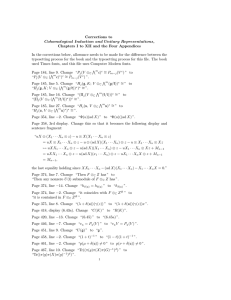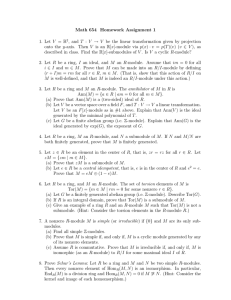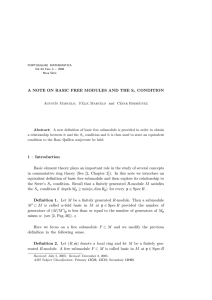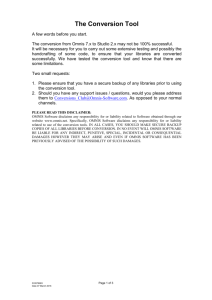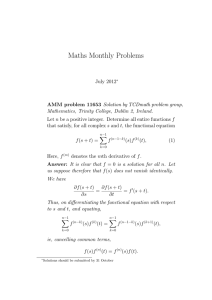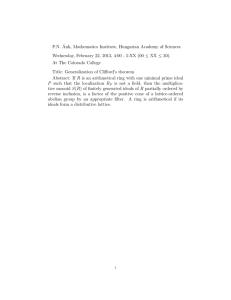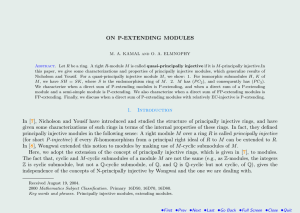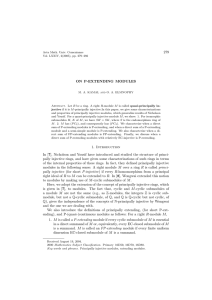Purity and Direct Summands Pureza y Sumandos Directos ∗ ´
advertisement
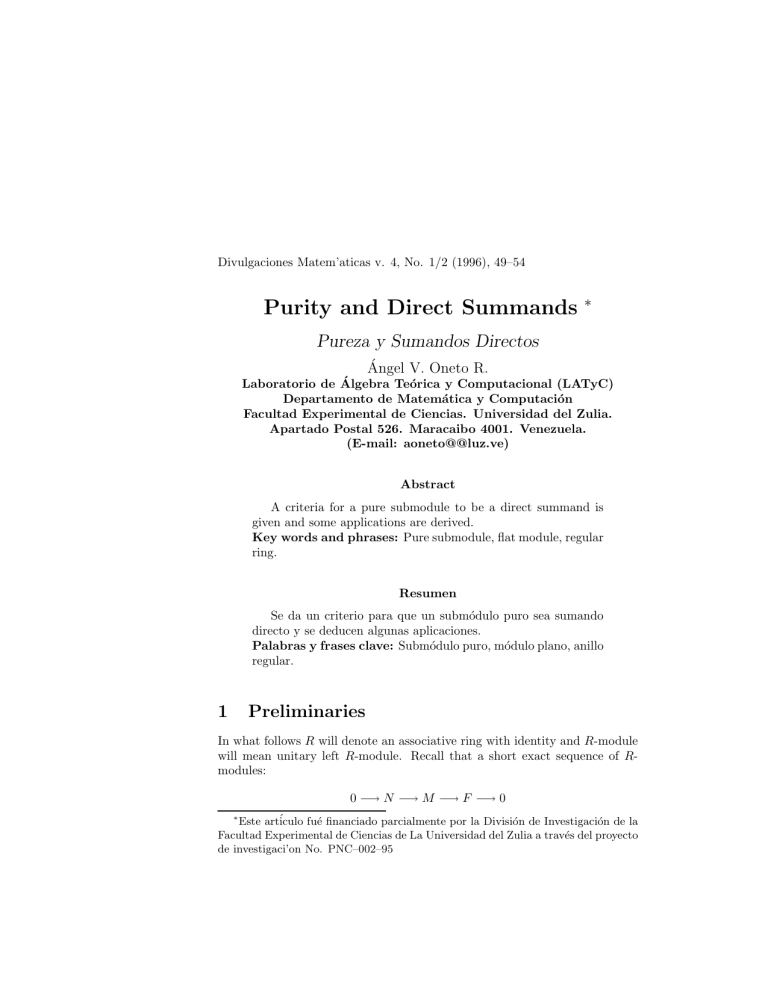
Divulgaciones Matem’aticas v. 4, No. 1/2 (1996), 49–54 Purity and Direct Summands ∗ Pureza y Sumandos Directos Ángel V. Oneto R. Laboratorio de Álgebra Teórica y Computacional (LATyC) Departamento de Matemática y Computación Facultad Experimental de Ciencias. Universidad del Zulia. Apartado Postal 526. Maracaibo 4001. Venezuela. (E-mail: aoneto@@luz.ve) Abstract A criteria for a pure submodule to be a direct summand is given and some applications are derived. Key words and phrases: Pure submodule, flat module, regular ring. Resumen Se da un criterio para que un submódulo puro sea sumando directo y se deducen algunas aplicaciones. Palabras y frases clave: Submódulo puro, módulo plano, anillo regular. 1 Preliminaries In what follows R will denote an associative ring with identity and R-module will mean unitary left R-module. Recall that a short exact sequence of Rmodules: 0 −→ N −→ M −→ F −→ 0 ∗ Este artículo fué financiado parcialmente por la División de Investigación de la Facultad Experimental de Ciencias de La Universidad del Zulia a través del proyecto de investigaci’on No. PNC–002–95 50 Ángel Oneto is pure if it remains exact after being tensored with any right R-module. If N is a submodule of a R-module M and the canonical short exact sequence 0 −→ N −→ M −→ M/N −→ 0 is pure, then we say that N is a pure submodule of M . It follows at once that: Lemma 1 Every direct summand is a pure submodule. For completeness we sketch a proof of the following well known result Lemma 2 Let 0 −→ N −→ P −→ F −→ 0 be a short exact sequence of R-modules with P flat. The sequence is pure exact ⇐⇒ F is flat. Proof: Both implications can be obtained by diagram chasing. For example, assume F flat. We have to prove that N N N 0 −→ M N −→ M P −→ M F −→ 0 is exact for any right R-module M . Choose a short exact sequence 0 −→ S −→ L −→ M −→ 0 with L free. The result follows by diagram chasing applied to the following diagram with exact rows and columns: S S 0 −→ S N ↓ N ↓ N ↓ 0 N P F −→ L −→ L −→ L 0 ↓ N ↓ N ↓ N ↓ 0 N P F −→ M −→ M −→ M N ↓ N ↓ N ↓ 0 N −→ 0 P −→ 0 F −→ 0 Recall the characterization of a (Von Neumann) regular ring as a ring R such that every R-module is flat. From this and the above definition of purity it follows (noted by Gentile [2]) that: Purity and Direct Summands 51 Lemma 3 R is a regular ring if and only if any submodule (of any R-module) is pure. Recall also the following characterization of purity due to P. M. Cohn [1]: a submodule N of an R-module M is pure if and only if for any finite family n (xi )m i=1 of elements of N , any finite family (yj )j=1 of elements of M , and relations X xi = aij yj (aij ∈ R , i = 1, . . . , m , j = 1, . . . , n) j there exist z1 , . . . , zn ∈ N such that xi = X aij zj j 2 Some purity results The next theorem is a partial converse of Lemma 1: Theorem 4 If P is a projective R-module and N a finitely generated pure submodule of P , then N is a direct summand of P . Proof: Suppose first that P is free with basis (ej )j∈J . Choose a finite set (xi )m i=1 of generators of N . We have X xi = aij ej (i = 1, . . . , m) j∈J0 for some aij ∈ R and finite J0 ⊂ J. By purity there exist zj ∈ N (j ∈ J0 ) such that X aij zj xi = j∈J0 Define α : P −→ N by α(ej ) = zj if j ∈ J0 and α(ej ) = 0 if j 6∈ J0 . If β : N −→ P is the inclusion map, we have αβ = 1N and so N is a direct summand of P . For the general case, there exists a free R-module L such that P is a direct summand of L. By the particular case N is a direct summand of L L 0 L=N N 52 Ángel Oneto then P = N L (N 0 ∩ P ) and N is a direct summand of P . Now we give a criteria of purity: Proposition 5 Let N be a submodule of a R-module M . If N is projective and every map f : N −→ R can be extended to a map f 0 : M −→ R, then N is a pure submodule of M . Proof: Consider the situation xi = X aij yj j where xi ∈ N , yj ∈ M , aij ∈ R for i = 1, . . . , m , j = 1, . . . , n. Being N projective there exist a set of generators (eh )h∈H of N and a set (fh )h∈H of linear functionals fh : N −→ R such that for each x ∈ N, fh (x) = 0 for almost all h, and x= X fh (x)eh h By hypothesis fh extends to fh0 : M −→ R and then fh (xi ) = X aij fh0 (yj ) j ∀h ∈ H. So xi = X fh (xi )eh = h X j X aij ( fh0 (yj )eh ) h and N is a pure submodule of M . 3 Applications In this section we show the ubiquity of Theorem 4, obtaining results that arises in several different contexts. The first application is a classical theorem due to Villamayor: Corollary 6 A finitely presented flat module is projective. Purity and Direct Summands 53 Proof: Let F be a finitely presented and flat R-module. We have an exact sequence 0 −→ N −→ L −→ F −→ 0 where L is free and N a finitely generated submodule of L. By Lemma 2, N is a pure submodule of L and, by Theorem 4, a direct summand of L (i.e. the sequence splits). Hence F is projective. The next result is due to Kaplansky ([3], Th.1.11). Corollary 7 If P is a projective module over a regular ring then every finitely generated submodule of P is a direct summand. Proof: Since over a regular ring every submodule (of any module) is pure (Lemma 3), the result follows from Theorem 4. As a final application we give a variation of a result due to Gentile ([2], Prop. 3.1). Recall that a left semihereditary ring is a ring such that every finitely generated submodule of a finitely generated projective module is also projective. Corollary 8 A ring R is regular if and only if it is left semihereditary and for any finitely generated projective R-module P , and any finitely generated submodule N of P , every map f : N −→ R extends to f : P −→ R. Proof: Assume R regular and let N be a finitely generated submodule of a finitely generated projective R-module P . By Lemma 3 and Theorem 4, N is a direct summand of P . It follows that R is left semihereditary and the property of extension of maps holds. Conversely (recall the characterization of a regular ring as a ring such that any finitely generated left ideal is a direct summand) let I be a finitely generated left ideal of R. Being R semihereditary I is projective and then by Proposition 5 it is a pure submodule of R. Finally, by Theorem 4, I is a direct summand of R. 4 Final comment Theorem 4, as one of the referees pointed out to the author, may also be obtained as a consequence of a result of O. Villamayor (see Lemma 2.2 in [4]). 54 Ángel Oneto References [1] Cohn, P. M. On the Free Product of Associative Rings 1, Math. Zeit., 71, (1959), 380–398. [2] Gentile, E. R. Purity and Algebraic Closure, Rev. Union Mat. Arg. 24(1), (1968) 37–47. [3] Goodearl, K. R. Von Neumann Regular Rings, Pitman, London, l979. [4] Ware, R. Endomorphism Rings of Projective Modules, Trans. Am. Math. Soc. 155(1), (1971), 233–256.
![1. Let R = C[x].](http://s2.studylib.net/store/data/010491179_1-9a9c70e395518f466f652079f02ae14a-300x300.png)
